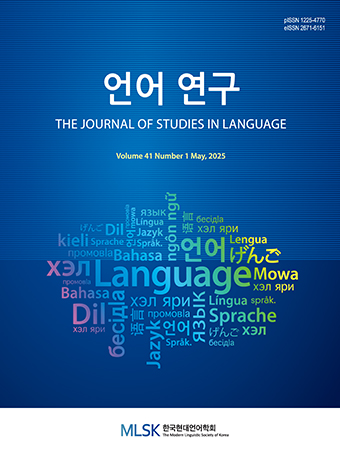Research Article
Abstract
References
Information
This study explores how young Korean children produce and perceive stop contrasts in the phonetic dimension of F0. The Korean spoken in Seoul is undergoing tonogenetic sound change in which there has been a loss of VOT differentiation in young adults’ speech, while the role of fundamental frequency (F0) in enhancing Korean stop contrasts has been required. To investigate the interrelation between children’s production and perception of F0, the experiments were conducted on three-year-old children. Phonetic analysis showed that lenis and aspirated stops have no significant VOT differences, whereas a significant relationship with F0 was found. The results suggest that the acquisition of F0 plays a crucial role in the formation of phonemic categories for lenis and aspirated stops and this process significantly affects articulatory distinction. (Kwangwoon University)
- Allen, G. 1985. How the Young French Child Avoids the Pre-Voicing Problem for Word-Initial Voiced Stops. Journal of Child Language 12, 37-46. 10.1017/S0305000900006218 3980606
- Bates, D., Maechler, M., Bolker,B., and Walker, S. 2015. Fitting Linear Mixed-Effects Models Using lme4. Journal of Statistical Software 67.1, 1-48. 10.18637/jss.v067.i01
- Boersma, P. 2001. Praat, a System for Doing Phonetics by Computer. Glot International 5(9/10), 341-345.
- Clumek, H., Barton, D., Macken, M. A., and Huntington, D. 1981. The Aspiration Contrast in Cantonese Word-Initial Stops: Data from Children and Adults. Journal of Chinese Linguistics 9, 210-224.
- Gandour, J., Petty, S. H., Dardarananda, R., Dechongkit, S., and Mukongoen, S. 1986. The Acquisition of the Voicing Contrast in Thai: A Study of Voice Onset Time in Word-Initial Stop Consonants. Journal of Child Language 13, 561-572. 10.1017/S0305000900006887 3793815
- Haudricourt, A. G. 1954. De l'origine des tons du Vietnamien. Journal Asiatique 242, 69-82.
- Hombert, J-M., Ohala, J. J., and Ewan, W. G. 1979. Phonetic Explanations for the Development of Tones. Language 55, 37-58. 10.2307/412518
- Jun, S. -A. 1996. Influence of Microprosody on Bacroprosody: A Case of Phrase Initial Strengthening. UCLA Working Papers in Phonetics, 97-116
- Kang, Y. 2014. Voice Onset Time Merger and Development of Tonal Contrast in Seoul Korean Stops: A Corpus Study. Journal of Phonetics 45, 76-90. 10.1016/j.wocn.2014.03.005
- Kewley-Port, D., and Preston, M. S. 1974. Early Apical Stop Production: A Voice Onset Time Analysis. Journal of Phonetics 2: 195-210.
- Kim, M., and Stoel-Gammon, C. 2009. Tha Acquisition of Korean Word-Initial Stops. Journal of Acoustical Society of America 125.6, 3950-3961. 10.1121/1.3123402 19507977
- Kim, S. -H. 1999. Multiple Acoustic Cues of Three-Way Phonemic Contrast in Stop Consonants. Studies in Phonetics, Phonology and Morphology 5, 79-103.
- Klatt, D. 1975. Voice Onset Time, Frication, and Aspiration in Word-initial Consonant Clusters. Journal of Speech and Hearing Research 18, 686-706. 10.1044/jshr.1804.686 1207100
- Kong, E. J., Beckman, M. E., and Edwards, J. 2011. Why are Korean Tense Stops Acquired so Early?: The Role of Acoustic Properties. Journal of Phonetics 39, 196-211. 10.1016/j.wocn.2011.02.002 21643475 PMC3105898
- Kuhl, P. K., Williams, K., Lacerda, F., Stevens, K., & Lindblom, B. 1992. Linguistic Experience Alters Phonetic Perception in Infants by 6 Months of Age. Science 255, 606-608. 10.1126/science.1736364 1736364
- Ladefoged. P., and Maddieson, I. 1996. The Sounds of the World's Language. Oxford: Blackwell. PMC178011
- Liljencrantz, J., and Lindblom, B. 1972. Numerical Simulations of Vowel Quality Systems: The Role of Perceptual Contrast. Language 48, 839-862. 10.2307/411991
- Lindblom, B. 1990. Explaining Phonetic Variation: A Sketch of the H & H Theory. In W. J. Hardcastle & A. Marchal (eds.), Speech Production and Speech Modeling (pp. 403-439). Dordrecht:Kluwer. 10.1007/978-94-009-2037-8_16
- Lindblom, B. and Engstrand, O. 1989. In What Sense is Speech Quantal? Journal of Phonetics 17, 107-121.
- Lisker, L. and Abramson, A. S. 1964. Cross-Language Study of Voicing in Initial Stops: Acoustical Measurements. Word 20, 384-422. 10.1080/00437956.1964.11659830
- Pae, S., Chang, Y., Kwak, K., Sung, H., and Sim, H. 2004. MCDI-K Referenced Expressive Word Development of Korean Children and Gender Differences. Korean Journal of Communication Disorder 9, 45-56.
- Pan, H. S. 1994. The Voicing Contrasts of Taiwanese (Amoy) Initial Stops: Data from Adults and Children. Ph.D. Dissertation, Ohio State University, Columbus, OH.
- Polka, L., and Werker, J. F. 1994. Developmental Changes in Perception of Non-Native Vowel Contrasts. Journal of Experimental Psychology: Human Perception and Performance 20, 421-35. 10.1037/0096-1523.20.2.421 8189202
- R Development Core Team. 2011. R: A Language and Environment for Statistical Computing. Vienna, Austria: R Foundation for Statistical Computing. (http://www.r-project.org/)
- Raudenbush, S. W., and Bryk, A. S. 2002. Hierarchical Linear Models (2nd edition). Thousand Oaks, California: Sage. 12027363
- Silva, D. J. 2006. Acoustic Evidence for the Emergence of Tonal Contrast in Contemporary Korean. Phonology 23, 287-308. 10.1017/S0952675706000911
- Snijders, T., and Bosker, R. 1999. Multilevel Analysis. London: Sage.
- Swingley, D., and Aslin, R. N. 2007. Lexical Competition in Young Children's Word Learning. Cognitive Psychology 54, 99-132. 10.1016/j.cogpsych.2006.05.001 17054932 PMC2613642
- Werker, J., and Tees, R. 1984. Cross-Language Speech Perception: Evidence for Perceptual Reorganization During the First Year of Life. Infant Behavior and Development 7, 49-63. 10.1016/S0163-6383(84)80022-3
- Wright, J. D. 2007. Laryngeal contrast in Seoul Korean. Ph.D. Dissertation, University of Pennsylvania, Philadelphia, PA.Gayeon Son, Professor
- Publisher :The Modern Linguistic Society of Korea
- Publisher(Ko) :한국현대언어학회
- Journal Title :The Journal of Studies in Language
- Journal Title(Ko) :언어연구
- Volume : 34
- No :3
- Pages :505-518
- DOI :https://doi.org/10.18627/jslg.34.3.201811.505




 The Journal of Studies in Language
The Journal of Studies in Language






